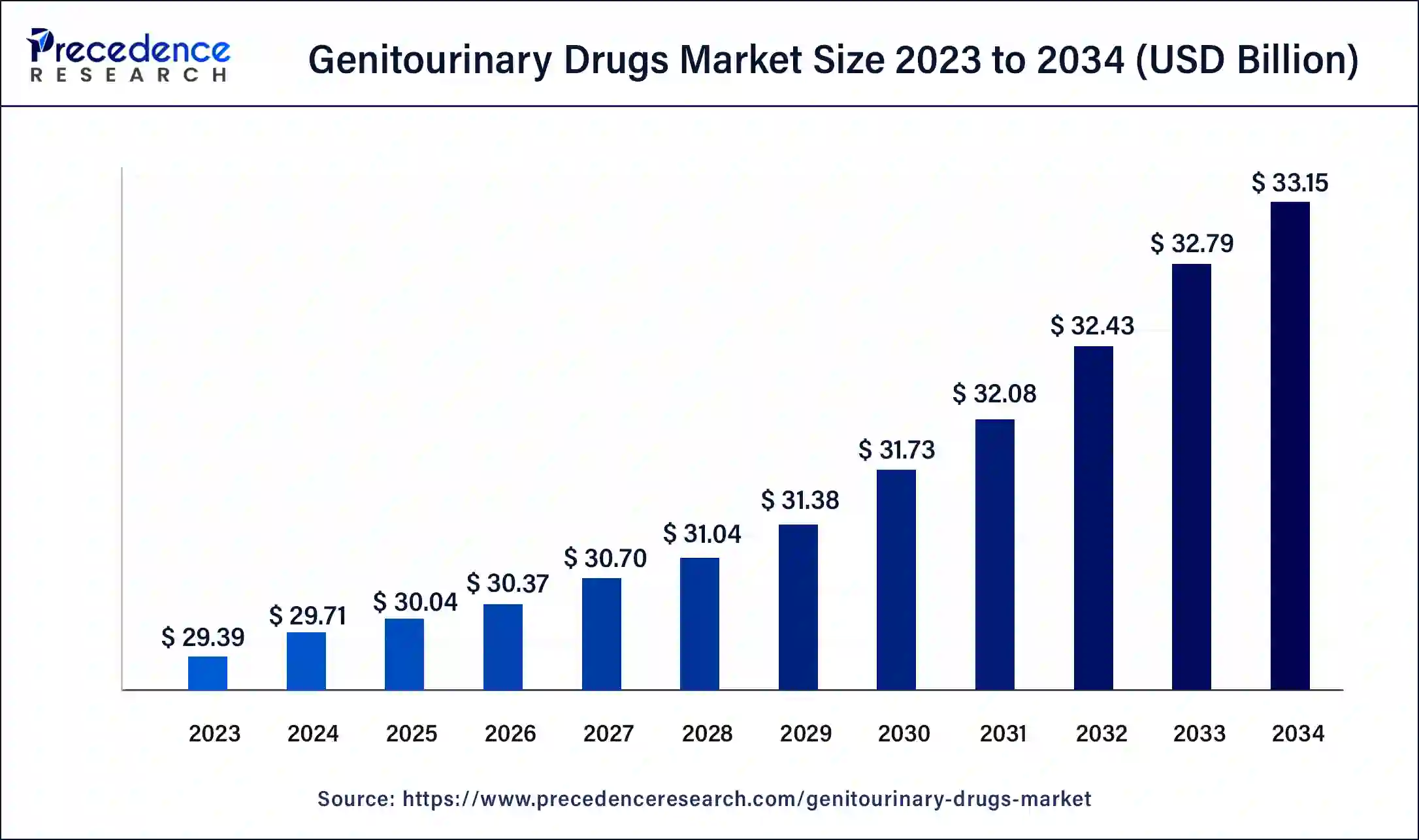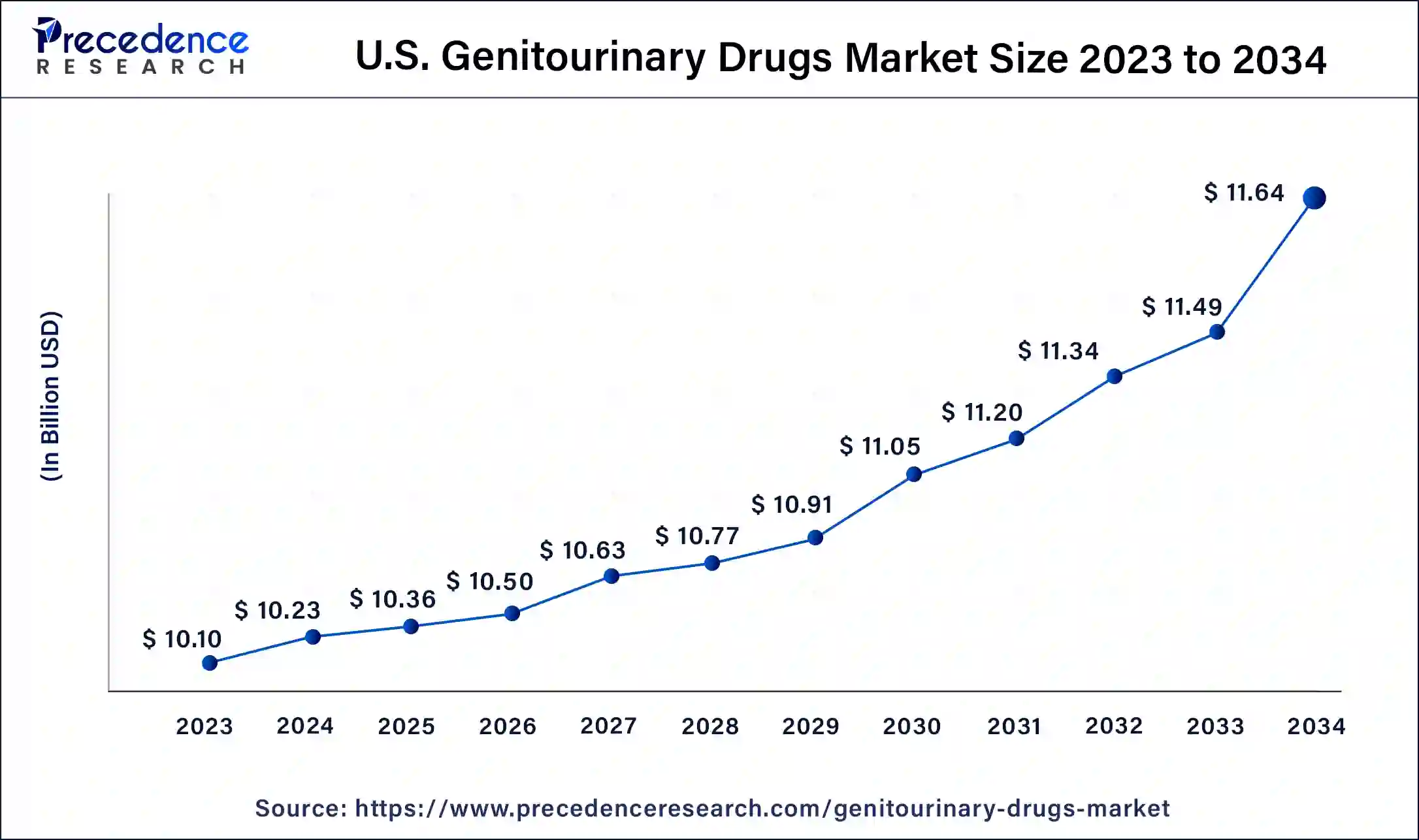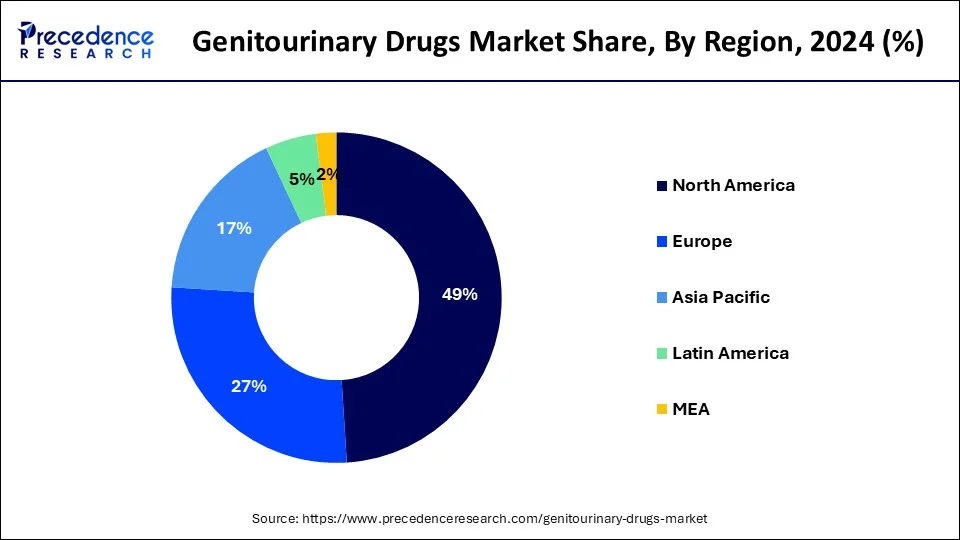List of Contents
Genitourinary Drugs Market Size and Forecast 2025 to 2034
The global genitourinary drugs market size accounted at USD 29.71 billion in 2024 and is expected to be worth around USD 33.15 billion by 2034, at a CAGR of 1.10% from 2025 to 2034. The North America genitourinary drugs market size reached USD 14.56 billion in 2024.

Genitourinary Drugs Market Key Takeaways
- The global genitourinary drugs market was valued at USD 29.71 billion in 2024.
- It is projected to reach USD 33.15 billion by 2034.
- The genitourinary drugs market is expected to grow at a CAGR of 1.10% from 2025 to 2034.
- North America contributed more than 49% of revenue share in 2024.
- Asia-Pacific is estimated to witness the fastest CAGR between 2025 and 2034.
- By indication, the prostate cancer segment held the largest market share of 28% in 2024.
- By indication, the cervical cancer segment is anticipated to grow at a remarkable CAGR of 2.5% between 2025 and 2034.
- By product, the hormonal therapy segment generated over 38% of revenue share in 2024.
- By product, the gynecological segment is expected to expand at the fastest CAGR over the projected period.
U.S. Genitourinary Drugs Market Size and Growth 2025 to 2034
The U.S. genitourinary drugs market size was estimated at USD 10.23 billion in 2024 and is predicted to be worth around USD 11.64 billion by 2034, at a CAGR of 1.30% from 2025 to 2034.

North America has held the largest revenue share of 49% in 2024. North America holds a major share in the genitourinary drugs market due to several factors. The region benefits from advanced healthcare infrastructure, high healthcare spending, and a robust research and development environment. Additionally, a large patient population with a high prevalence of genitourinary disorders, coupled with favorable reimbursement policies, contributes to market dominance. The presence of key pharmaceutical companies and a proactive approach towards adopting innovative medical solutions further solidify North America's prominent position in the Genitourinary Drugs market.

Asia-Pacific is estimated to observe the fastest expansion. Asia-Pacific holds a significant share in the genitourinary drugs market due to several factors. The region's large and diverse population, coupled with a rising incidence of genitourinary disorders, contributes to substantial market demand. Additionally, increasing healthcare awareness, improving healthcare infrastructure, and growing investments in research and development further propel market growth. The prevalence of conditions like urinary tract infections and reproductive health issues has led to a heightened demand for genitourinary drugs in the Asia-Pacific, solidifying its prominent position in the global market.
Market Overview
Genitourinary drugs represent a distinctive category of pharmaceuticals meticulously crafted to tackle disorders impacting both the urinary and reproductive systems. These medications play a pivotal role in effectively managing a spectrum of health conditions, spanning urinary tract infections, erectile dysfunction, prostate disorders, and various challenges in reproductive health. The landscape of genitourinary drugs encompasses a diverse array of treatments, encompassing antibiotics for precision in infection control, hormonal therapies to nurture reproductive health, and specialized medications tailored for nuanced conditions such as benign prostatic hyperplasia or overactive bladder.
The effectiveness of genitourinary drugs is paramount for proficiently handling symptoms, averting complications, and globally elevating patient well-being within the domain of genitourinary health. The pharmaceutical industry demonstrates unwavering commitment to research and development, consistently unveiling groundbreaking medications to broaden the array of available treatment options and enhance their effectiveness.
As medical insights progress, a focused effort is directed towards creating precision-targeted and personalized therapies within the genitourinary field, illustrating a steadfast dedication to addressing the ever-evolving healthcare needs of individuals grappling with challenges in the urinary and reproductive systems.
Genitourinary Drugs Market Growth Factors
- The growing number of urinary and reproductive system issues is boosting the demand for genitourinary drugs.
- As more people age, there's an increased need for genitourinary drugs to address age-related problems like prostate disorders and urinary challenges.
- Continuous efforts in research and development are introducing newer and more effective genitourinary drugs.
- Growing awareness and education about reproductive health are spurring a greater demand for drugs related to fertility and reproductive disorders.
- Improved Diagnostic Technologies: Advances in diagnostic tools are allowing early detection of genitourinary conditions, leading to a higher demand for suitable treatments.
- Improvements in healthcare infrastructure, especially in emerging markets, are broadening access to genitourinary drugs, driving market growth.
- Changes in lifestyle habits contribute to a rise in lifestyle-related genitourinary disorders, prompting the need for pharmaceutical solutions.
- The increasing elderly population is more susceptible to various genitourinary issues, creating a sustained demand for specialized medications.
- More urological surgeries, like prostate procedures, are increasing the demand for post-operative genitourinary drugs.
- The growing acceptance of hormonal therapies for reproductive health is contributing to the expansion of the market.
- Higher global healthcare spending allows for greater accessibility to advanced genitourinary drugs and treatments.
- The prevalence of sexually transmitted infections emphasizes the need for pharmaceutical interventions in the genitourinary field.
- More individuals seeking treatment for erectile dysfunction are fueling the growth of the genitourinary drugs market.
- Supportive government initiatives and policies focused on reproductive health are positively impacting the genitourinary drugs market.
- Heightened patient awareness and education about genitourinary health issues are encouraging early intervention and treatment.
- Continuous advancements in targeted therapies are improving the precision and effectiveness of genitourinary drugs.
- Growing investments in biopharmaceutical research are encouraging the development of novel genitourinary drugs.
- The expansion of distribution channels ensures a broader reach for genitourinary drugs.
- The increasing adoption of telemedicine is making it easier for individuals to access consultations and prescriptions for genitourinary conditions.
- Evolving regulatory frameworks are creating a conducive environment for the development and commercialization of genitourinary drugs.
Market Scope
| Report Coverage | Details |
| Market Size in 2024 | USD 29.71 Billion |
| Market Size in 2025 | USD 30.04 Billion |
| Market Size by 2034 | USD 33.15 Billion |
| Growth Rate from 2025 to 2034 | CAGR of 1.10% |
| Largest Market | North America |
| Base Year | 2024 |
| Forecast Period | 2025 to 2034 |
| Segments Covered | By Indication and By Product |
| Regions Covered | North America, Europe, Asia-Pacific, Latin America, and Middle East & Africa |
Market Dynamics
Driver
Government initiatives for reproductive health and rise in urological surgeries
Government initiatives focused on reproductive health play a pivotal role in surging the market demand for genitourinary drugs. Supportive policies, funding, and awareness campaigns drive accessibility to reproductive healthcare, leading to an increased demand for pharmaceutical interventions. These initiatives often include family planning programs, sexual education, and affordable healthcare services, creating a conducive environment for the growth of the genitourinary drugs market.
As governments prioritize reproductive health as a public health concern, the demand for drugs addressing conditions like fertility issues and reproductive disorders sees a significant upswing. Simultaneously, the rise in urological surgeries is a key driver amplifying the demand for genitourinary drugs. An increase in procedures such as prostate surgeries necessitates post-operative care, driving the market for drugs tailored to recovery and long-term management.
The growing prevalence of urological surgeries, coupled with advancements in surgical techniques, contributes to a heightened demand for pharmaceutical solutions, further propelling the expansion of the genitourinary drugs market.
Restraint
Stringent regulatory approval processes and social stigma
Stringent regulatory approval processes and social stigma act as significant restraints in the genitourinary drugs market. The extensive and rigorous procedures required for regulatory approvals often lead to delays in bringing new drugs to market. The lengthy timelines and stringent criteria create challenges for pharmaceutical companies, slowing down innovation and limiting the availability of novel treatments for genitourinary conditions. Social stigma surrounding genitourinary issues further restrains market demand.
Stigmatization can discourage individuals from seeking medical help, leading to underreporting and delayed diagnosis. This reluctance to address genitourinary health concerns not only affects patient well-being but also hampers the market potential for related drugs. Overcoming these challenges necessitates not only streamlined regulatory pathways but also comprehensive efforts to destigmatize genitourinary conditions, fostering a more open and supportive environment for patients and healthcare providers alike.
Opportunity
Increasing healthcare awareness and increased patient education initiatives
The genitourinary drugs market is benefiting from the rise in healthcare awareness and increased efforts in patient education. As people become more informed about genitourinary health issues, there is a growing tendency to seek medical help early on, leading to better outcomes. This increased awareness not only improves individual health but also fuels the demand for genitourinary drugs. Patients are more inclined to discuss their health concerns with healthcare providers, promoting collaborative approaches to managing and treating genitourinary conditions.
Concurrently, expanded patient education initiatives are empowering individuals to understand the significance of reproductive and urinary health. Well-informed patients are more likely to actively participate in treatment decisions and adhere to prescribed medications. Pharmaceutical companies can leverage this opportunity by developing targeted educational materials, creating a more knowledgeable and receptive market for genitourinary drugs. The intersection of healthcare awareness and patient education is fostering a positive environment for market growth, encouraging timely interventions and enhancing the acceptance of pharmaceutical solutions in genitourinary healthcare.
Indication Insights
The prostate cancer segment held the highest market share of 28% in 2024. Within the genitourinary drugs market, the prostate cancer segment pertains to pharmaceuticals crafted for combating prostate cancer, a widespread malignancy impacting the male reproductive system. Ongoing trends in this sector involve a rising focus on precision therapies, immunomodulatory treatments, and hormonal interventions to optimize effectiveness while mitigating adverse effects. There's a discernible surge in demand for inventive medications promising enhanced results, coupled with a notable shift towards personalized medicinal approaches tailoring treatments to the distinct features of prostate cancer in each patient.
The cervical cancer segment is anticipated to expand at a significant CAGR of 2.5% during the projected period. The cervical cancer segment in the genitourinary drugs market focuses on medications addressing this specific form of cancer affecting the cervix. Trends in this segment indicate a growing emphasis on targeted therapies, immunotherapies, and advancements in precision medicine. Ongoing research is fueling the development of innovative drugs aimed at improving treatment efficacy and minimizing adverse effects. Additionally, increased awareness about cervical cancer screenings and vaccination programs is contributing to early detection, influencing the demand for genitourinary drugs tailored to combat this particular indication.
Product Insights
According to the product, the hormonal therapy segment has held a 38% revenue share in2024. The hormonal therapy segment in the genitourinary drugs market encompasses medications designed to regulate hormonal imbalances affecting the reproductive system. Commonly used for conditions like erectile dysfunction and hormonal disorders, these drugs aim to restore hormonal equilibrium. A notable trend in this segment involves ongoing research to develop advanced hormonal therapies with fewer side effects, enhancing patient compliance. The pursuit of more targeted and personalized hormonal treatments is a key trend, reflecting the industry's commitment to improving efficacy and minimizing adverse effects in the genitourinary drugs market.
The gynecological segment is anticipated to expand fastest over the projected period. In the genitourinary drugs market, the gynecological segment encompasses pharmaceuticals specifically designed to address conditions related to women's reproductive health. This includes medications for menstrual disorders, hormonal therapies, fertility treatments, and drugs addressing gynecological cancers. Recent trends in this segment focus on the development of innovative hormonal therapies, targeted treatments for gynecological cancers, and advancements in contraceptives. With a growing emphasis on women's health, the gynecological segment is witnessing increased research and development, aiming to provide more effective and tailored solutions for diverse reproductive health needs.
Genitourinary Drugs Market Companies
- Pfizer Inc.
- GlaxoSmithKline plc
- Johnson & Johnson
- Novartis AG
- Eli Lilly and Company
- AstraZeneca PLC
- Bayer AG
- Sanofi S.A.
- Merck & Co., Inc.
- Bristol-Myers Squibb Company
- Astellas Pharma Inc.
- Boehringer Ingelheim International GmbH
- AbbVie Inc.
- F. Hoffmann-La Roche Ltd.
- Takeda Pharmaceutical Company Limited
Recent Developments
- In April 2023, GSK plc reported encouraging results from the EAGLE-2 and EAGLE-3 clinical trials for gepotidacin. The positive outcome in Phase III trials positions gepotidacin as a potential breakthrough, being the first orally administered antibiotic in its class for treating uncomplicated urinary tract infections (uUTI) in female adolescents and adults.
- In March 2023, Pfizer Inc. disclosed its definitive merger agreement with Seagen Inc., a biotechnology firm known for its innovation in cancer medicines and expertise in antibody-drug conjugate (ADC) technology. This strategic collaboration marks a significant development in Pfizer's pursuit of advancements in cancer treatment and underscores Seagen's valued position in the field.
Segments Covered in the Report
By Indication
- Prostate Cancer
- Ovarian Cancer
- Bladder Cancer
- Cervical Cancer
- Renal Cancer
- Erectile Dysfunction
- Urinary Tract Infections
- Urinary Incontinence & Overactive Bladder
- Sexually Transmitted Diseases
- Interstitial Cystitis
- Haematuria
- Benign Prostatic Hyperplasia
By Product
- Urologicals
- Hormonal Therapy
- Gynecological
- Anti-infectives
- Others
By Geography
- North America
- Europe
- Asia-Pacific
- Latin America
- Middle East and Africa
For inquiries regarding discounts, bulk purchases, or customization requests, please contact us at sales@precedenceresearch.com
Frequently Asked Questions
Ask For Sample
No cookie-cutter, only authentic analysis – take the 1st step to become a Precedence Research client